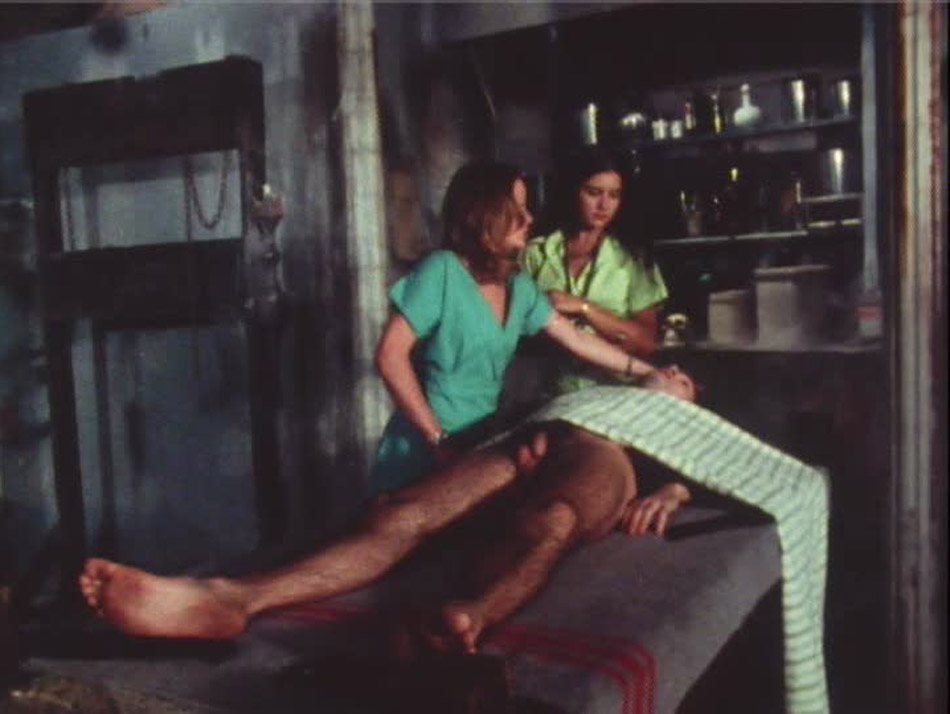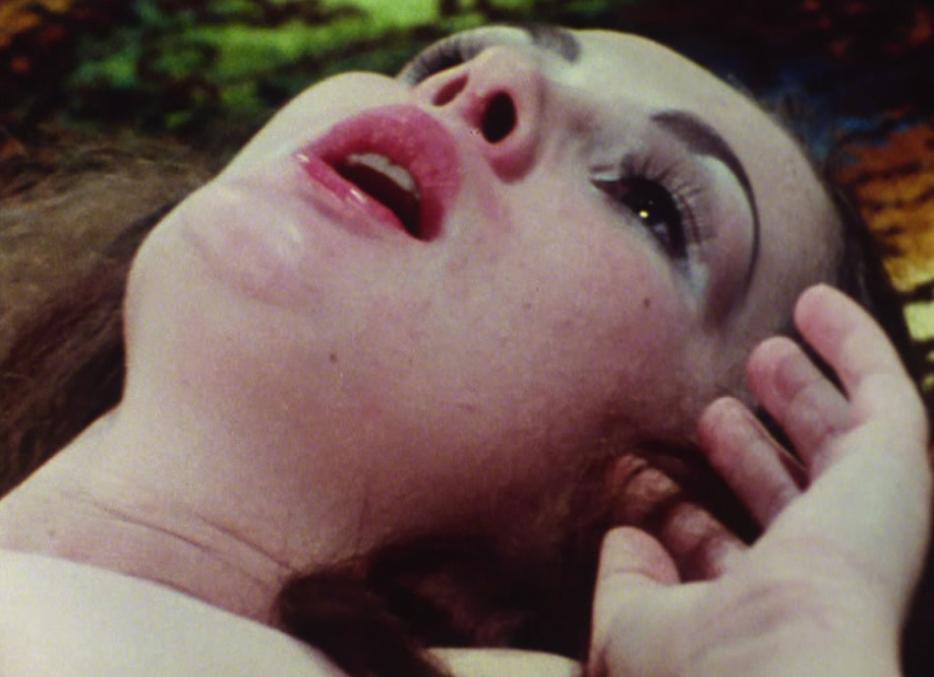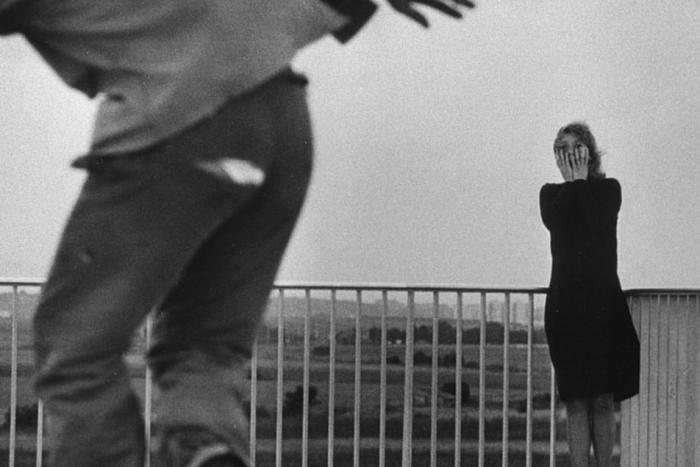Halfway through Sexcula—a 1974 Canadian film released on DVD, by Synapse Films, for the first time last week—a gorilla is unleashed during a sex party at the shapely Dr. Fallatingstein’s castle. Why the gorilla is there in the first place is uncertain. We know from the doctor’s lab equipment that she is a scientist, and we know from her peculiarly sexual inventions (i.e. a “Female Pleasure Robot”) that she is mad; perhaps he’s a botched experiment. Whatever his purpose, there is no doubting his libido: gorilla or no gorilla, he gets down on that gravelly floor and has sex with a stripper.
Nobody would call Sexcula a shining example of Canada’s national cinema, and for nearly 40 years it went unseen, the only known print filed away in the National Archives. Still, it claims a footnote in this country’s history. Deep Throat’s box office success had spawned a “golden age of pornography” in the United States, but while porn production reached unprecedented heights in New York and Los Angeles, Sexcula was our nation’s only contribution to the boom: hardcore movies were illegal in western Canada and legally uncertain in the east. This didn’t seem to concern Clarence Neufeld, Sexcula’s wealthy producer, who was not looking to make a masterpiece. In 1973, his income as a building contractor had far exceeded his expectations; his accountant suggested investing the surplus income in a film, and, noting that sex was an easy sell, suggested porn.
Two years earlier, to encourage expansion of Canada’s film industry, the federal government’s Canadian Film Development Corporation had implemented a 100 percent capital cost allowance on film investment. (This “tax shelter era” famously spawned Porky’s, Meatballs, early David Cronenberg, and dozens of exploitation films that stopped short of explicit penetration.) Neufeld had no prior experience in filmmaking and apparently harbored no cinematic ambitions. But he did have some industry connections, including writer David F. Hurry, who had contributed to The Littlest Hobo and who pumped out a horror/sex comedy script at Neufeld’s request. Filming was spread over three weeks in August, with a crew of Littlest Hobo alumni and a cast laced with local sex workers.
*
The plot: a vacationing couple finds an old book in an abandoned house, chronicling the strange happenings within its walls in the 18th century. In flashback, we meet Dr. Fallatingstein, a libidinous scientist who creates a man to satisfy her sexual cravings—alas, the creation (“Frank”) proves impotent, and in desperation, she calls on her cousin, Countess Sexcula, to rouse his lust. Sexcula gives it the old college try, but upon further investigation determines that he is lacking “sex cells.” Undaunted, she uses her feminine charms to abduct eligible men as unwilling donors.
Characters drift in and out, and plot strands get tangled: Orgie, an Igor-like lab assistant, flashes his heaving buttocks while mounting a Female Pleasure Robot. There is the gorilla, the stripper, and their unpleasant sexual encounter; then, at the two-thirds mark, with almost no context, the film cuts to a completely different time and place for a scene in which a bride and groom turn a wedding into a honeymoon.
“The film probably got made without much sense of what they were going to do when it was done,” says Dimitrios Otis, the “porn archeologist” behind Sexcula’s new DVD release. From the beginning, it was a troubled production. Within days of shooting, the cinematographer was fired, followed quickly by the director. John Holbrook, a 27-year-old who’d been hired as an assistant cameraman (he was an uncredited assistant on McCabe and Mrs. Miller), volunteered to take the reins. “Holbrook almost got himself fired as well because he was sheepish about shooting the sex,” says Mirko Mladenovic, who negotiated the DVD release between Neufeld and Otis. “He started shooting Sexcula as a dramedy without the sex, and after a few days Neufeld confronted John about this. The next day [Neufeld] got the sex he was looking for.”
“Nobody really knew what they were doing,” says Holbrook. “I basically came in and salvaged the film,” directing under the pseudonym Bob Hollowich. “Every day something would go wrong. Like, she didn’t bring her clothes today; why didn’t she bring her clothes today? Well, they’re at her friend’s laundry. Well, I’m continuing a scene, and now my actress doesn’t have the clothes that she was wearing yesterday. How do I do this? Alright, I’ll put a dissolve in there, it’s later on, and now she’s naked … It’s just flying by the seat of your pants.”

Cast members suffered substance abuse problems and one of the studs had trouble performing. Chemistry between the actors was nonexistent, and Jamie Orlando, who played Fallatingstein, was so repulsed by the actor playing Frank that she refused even a soft-core coupling—a difficult situation, since the story depended on their relationship’s consummation (in the end, Holbrook coaxed a limp kiss out of them). Orlando and Debbie Collins, who played Countess Sexcula, were “really low self-esteem girls,” says Holbrook. “These girls weren’t actors, and they knew that they were there to show their skin and perform things, and didn’t feel great about that.”
“They had a huge dialogue scene to do around Frank,” Holbrook continues. “I had to walk them through this scene to bring them up to the point where they thought, Yeah, we can do this, yeah, we’ll do this for John. So, I build them up to this point, and the production manager [who had a stutter] comes in and says, ‘W-w-w-what are you doing?!’ I said, ‘We’re just talking and we’re almost ready to go, we’re just rehearsing a bit here.’ He said, ‘No, no, no, no--th-th-th-they kn-kn-kn-know what they’re h-h-h-here for! Now just sp-sp-spread your legs and m-m-make movies!’ Those two girls, I looked at them and I just saw them whither in their own bodies.”
Sexcula pants and wheezes its way to the minimum 90-minute length required to qualify for its tax credit. When the film originally stalled at 70 minutes despite generous padding, Neufeld called Holbrook to shoot an additional 20 minutes with a different cast. Holbrook and company improvised a film-within-a-film, set at a porn studio decorated as a church, where an orgy erupts during a wedding. Tenuously connected to the main story through clunky narration, this section is also jarringly explicit compared to the rest of the film, which veers toward soft-core.
*
Sexcula screened at least once in 1974, at Vancouver’s long-gone Panorama Studios for cast, crew, and invited industry professionals. The event did not go well. “[Apparently] it was all these industry people expecting some Canadian feature film, and what they got was... y’know, a sex movie,” says Otis. Neufeld took the film to the United States to shop for distribution, but got discouraged by the low offers; satisfied with his tax refund, he let it languish in obscurity. Holbrook, who today teaches film production through his Movieskills workshop, was fine with that. “All I did was make it a finished film, really. Unfortunately, it had to be 90 minutes. At 45 minutes, I don’t mind some of the little gags--there are a couple of groaners in there that I’m kind of proud of. But overall, I would never set out to make a porn film.” (Neufeld, still a wealthy Vancouver resident, declines interview requests.)
Shortly after Sexcula was completed, a print was purchased by Archives Canada, which collected all films produced and financed in Canada. Over the decades, a groundswell of awareness built: stories from the production inspired Overnight (1986), a Vancouver comedy about the misadventures of a Canadian crew filming a horror-porno about “Countess Sexcula” (certain plot points—notably erectile dysfunction—are strikingly similar to what the Sexcula crew faced). Meanwhile, the title became a frequent joke among Archives Canada employees who saw it pop up in their catalogues, and merited a bemused mention in They Came from Within, Caelum Vatnsdal’s 2004 study of Canadian horror films.
In 2012, Paul Corupe, who reviews tax-shelter cinema for his website Canuxploitation, caught wind of the print’s existence, and through a contact at Archives Canada, arranged a screening. Thanks to his advocacy, word spread to Dimitrios Otis, a collector and film historian whose discoveries include Ed Wood’s long-lost final film, The Young Marrieds (1971). Otis went to work on negotiating a deal between Archives Canada and Clarence Neufeld for a digital scan of the surviving print. “What low-budget sex movie ever gets stored in archival conditions?” he marvels. “It never happens.”
The pastoral wraparounds, the Universal Horror-pastiche flashbacks, and the bluntly pornographic interludes combine for a schizophrenic viewing experience. And yet, against all odds, Sexcula has its small pleasures. Though never very funny, the film’s heavy-handed stabs at comedy are shameless enough to be endearing. The acting is charmingly amateurish, with Collins and Orlando blankly reciting their lines like idiot savant Bressons. And the 18th-century mis-en-scène, with overbearingly dark cinematography punctuated by flashes of neon colour, has a certain accidental beauty. These imperfections have probably never looked better than on DVD. And while viewers may never figure out whether Countess Sexcula is a vampire, voodoo queen, or something else entirely, she has finally become immortal.






